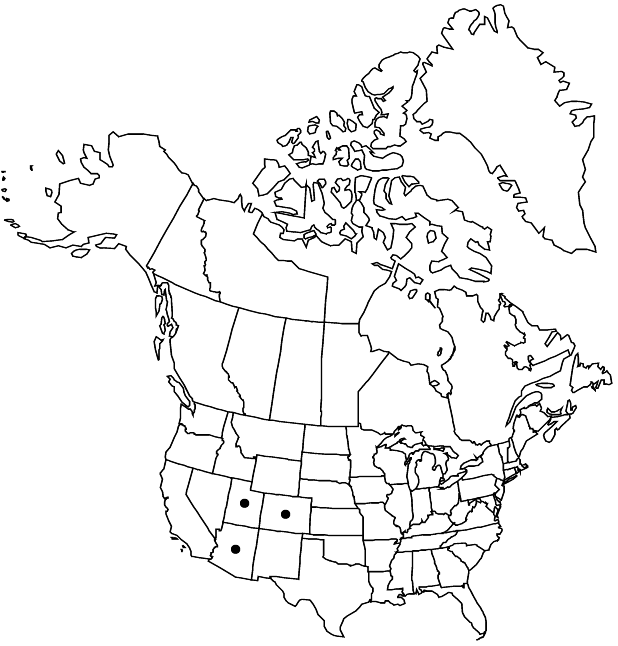Dodecatheon pulchellum var. zionense
Great Basin Naturalist 46: 259. 1986 ,.
Plants mostly glabrous. Leaves (8–)10–48 × 1.5–8.5 cm; blade elliptic to spatulate or nearly oval. Pedicels minutely glandular-puberulent. Flowers: calyx minutely glandular-puberulent; corolla tube yellow with maroon, thin, wavy ring, lobes magenta, 8–16(–20) mm; filament tube yellow basally, maroon distally, rarely wholly yellow or maroon, 1–3 mm; anthers 4.5–7 mm; pollen sacs usually dark maroon to black at least distally, connective usually maroon to black, rarely yellow.
Phenology: Flowering summer.
Habitat: Moist "hanging gardens" on cliffs usually in mixed oak and conifer woodlands
Elevation: 1100-2400 m
Distribution

Ariz., Colo., Utah.
Discussion
Variety zionense grows primarily in hanging gardens of north-central Arizona, southwestern Utah, in scattered, disjunct populations on the Colorado Plateau, and on the southern edge of the Uinta Mountains, Utah. In Colorado, var. zionense is known only from hanging gardens in Moffat County (S. O’Kane 3171, CS). The pollen sacs are basically maroon and fade to yellowish apically, unlike those of var. pulchellum which, in this area, has only maroon pollen sacs. The Uinta Mountains populations, segregated as subvar. huberi S. L. Welsh, occur at 2200 to 2400 meters; this phase has a maroon connective and a yellow filament tube. In Gray Canyon, a part of the Desolation Canyon area of Utah, both the connective and tube are yellow (N. D. Atwood and A. Evenden 24463, BRY); farther upriver at Dripping Springs, the connective and tube are maroon (N. D. Atwood and A. Evenden 24378, BRY). In Zion Canyon, the pollen sacs are purplish or at least heavily speckled with purple over yellow and the filament tube is proximally yellow and distally maroon. In White Canyon, Arizona, the tube is yellow and the connective purple (G. Rink 4829, NY). Without exception, at least the distal one-half to one-third of the pollen sac is purplish to maroon in all populations. As well, nearly all populations have minutely glandular pedicels and, often, calyces. Variation in stamen features may indicate that var. zionense, as defined here, comprises merely the ecological extremes of other variants, namely var. pulchellum and var. monanthum; the combinations of shade and continued moisture may be the only factors that promote the distinctive large leaf blades. Plants from the rim of Zion Canyon, which are small-leaved, are treated here as var. pulchellum, as are the small-leaved populations on seeping cliff-faces in Uintah County.
Selected References
None.